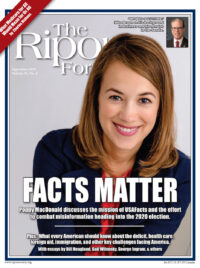
One of the most crucial components of a prosperous nation is the quality education of its youth. Education is routinely cited as a predictor of better health, a means to promote social equity and mobility, and a precursor to higher lifetime earnings. Not only that, but a well-educated population better prepares a country to compete in a more globalized world.
Like nearly all issues in American politics, education has become yet another topic where Americans are becoming more divided. Since the education and development of the next generation affects us all, it’s important to keep the facts in mind as we discuss what’s best for our children and for those who teach them.
School Funding is Down
Although they are trusted with the development of the next generation, America’s teachers are being squeezed by state and local funding. Budget cuts following the 2007-09 recession resulted in stagnant teacher salaries that are nearly 5% lower today than their high point in 2009/2010 despite teachers today being more educated and older than they were ten years ago. As a result, 1 in 6 teachers across the United States is working a second job year-round – not just during the summer months.
1 in 6 teachers across the United States is working a second job year-round – not just during the summer months.
An element of this is that K-12 education spending across the United States is still down 5.5% from pre-recession levels. These lingering cuts leave the United States with 135,000 fewer teachers than it had a decade earlier while also having to deal with 1.4 million more students in schools across the country. Yet, at the same time, public schools across the country have seen the number of school administrators grow nearly three times more than positions for teachers since 1950—further siphoning already sparse funds away from students’ classrooms.
These attenuated working environments are taking a toll on our educators, and in turn the quality of their teaching.
Our Students Underperform Compared to the World
Compared to other countries around the globe, students in the U.S. seem to be underperforming. According to the OECD, American students remain stuck in the middle of the pack for the core subjects of science, mathematics, and reading, where they ranked 25th, 38th, and 24th respectively. Though some analysts argue that these rankings may not be as bleak as they initially appear, the U.S., as the wealthiest country on earth, is still underperforming. Furthermore, despite efforts by individual states (through extensive standardized testing) and the federal government (through the introduction of Common Core standards) to raise standards, the U.S. has not improved on the OECD’s assessments since the first round of international testing in 2000.
As more countries develop and advance into post-industrial economies, the U.S. is no longer an uncontested global power. Developing countries are investing heavily in industry and education with the hopes of thriving in the new hyper-connected world marketplace. As the U.S. seeks to catch up, we must not only evaluate how to best teach students, but also what we need to teach students. The combination of each of the STEAM fields (science, technology, engineering, arts, and mathematics) serve as a foundation for students to equip themselves in a century where innovations and breakthroughs have become the currency of development and power.
Beyond international comparison, here at home, discrepancies can be seen in the quality of public education students receive. School district by school district and state by state, the quality of instruction and the performance of students can varies wildly. While some of this can be explained through disparities between tax bases and resources available to a given district, sometimes having enough money to spend isn’t the issue.
Washington, DC, for example, is a perennial laggard when compared to other cities of similar population and socioeconomic compositions. Yet schools in our nation’s capital spend at one of the highest levels in the country. At $22,000 per pupil in 2018, the District spends nearly $10,000 more per student than the national average and – compared to all 50 states – performs dead last. Even when compared to cities with similar enrollment levels (e.g. Atlanta Public Schools), DC schools still spend twice as much to achieve similar results.
Student Loan Debt is Up
In the United States, student loans make up the largest portion of non-housing debt in the country – affecting 1 in 3 Americans aged 18-29. In 2019, student debt nationwide ballooned to nearly $1.5 trillion, and this means that, on average, young Americans today are now leaving college with a bachelor’s degree in one hand and $25,000 worth of student loans in the other. While the present situation certainly isn’t ideal, it is positioned to only worsen with the cost of attending college growing at a pace 8 times greater than national wages. These oppressive financial commitments are acting as a barrier to economic progress for Millennials, leading them to postpone marriage, home ownership, and parenthood to much later in life than prior generations.
Mounting grievances on student loan debt have provided fertile ground for the development of radical policies from the 2020 Democratic primary field, including the proposal of eliminating college tuition and cancelling the student loan debt for most or all Americans, and, in turn, financing it via new and higher taxes on most Americans – whether they are wealthy or not. Many research institutions across the ideological spectrum conclude that the root cause of the problem is the federal government granting loans to high-risk borrowers and students attending colleges with low rates of increased earning potential for degrees.
Student loans make up the largest portion of non-housing debt in the country – affecting 1 in 3 Americans aged 18-29.
Innovative solutions such as income-share agreements, where repayment for financial assistance is based on a student’s income after graduation for a set period, have the potential to revolutionize the current system of paying for college. This strategy would end the practice of shackling today’s youth to decades of financial burden and replace it with a system where universities and private entities can invest in students rather than profiting off their interest payments.
Preparing the next generation of Americans for the future is in our nation’s greatest interest and is our society’s greatest investment, so as we debate as a country how best to improve the way we educate, the country should keep in mind the facts and realities of the challenges we face together.
Kyle Chance is the Deputy Editor of The Ripon Forum.




